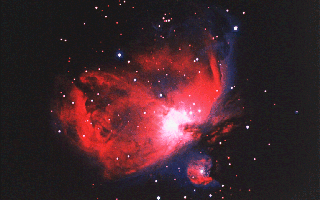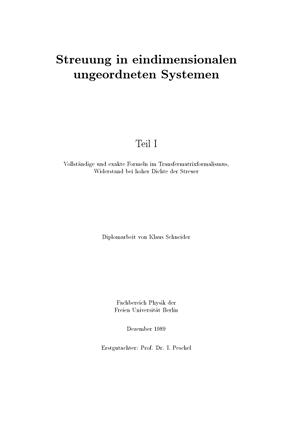|
For my geophysical web page
click here. |
|
||||
|
Scattering
in 1D disordered systems. Landauer-Model and Ohm’s law. Linear growth of
resistance in 1D disordered systems. |
|||||
|
|
******************************** If you are interested in
further information or discussion,
please contact the author via: ******************************** |
|
|||
|
If someone is interested in a complete analytical
solution of the scattering problem described by the one-dimensional
Schrödinger equation with random potentials, one can find it in my diplom
thesis. My diplom thesis is available in a German and in a partially
translated English version. In my thesis a random equivalent of the famous Kronig-Penney-Model is studied and
analytical formulae for all scattering properties are derived. The
mathematical method developed to average the product of random matrices might
be applied to other problems, which can be described by a product of random
matrices, too. If you want to read or to download my thesis just click on the
title pages shown below. Because of the restrictions to integrate figures in
LaTeX at the time of writing the thesis, the hand drawn potential shapes of
figures 1.1 and 2.1-2.4 are currently reproduced correctly only in the German
version. |
|||||
|
|
|
||||
|
I especially want to call the interested readers
attention to the point that a thorough investigation of the problem had
shown, that for special cases of disorder (presumably correlated scatterers)
a non-exponential growth of the resistance is possible, in fact the
resistance might grow even linear with the number of scatterers, i.e. show
the common ohmic behaviour of true 3D electrical conductors. This is also what John B. Pendry
in his review article Symmetry and transport of waves in 1D disordered
systems (J.
B. Pendry, Advances in Physics, 43, 461-542 (1994)) says, when he
on page 535-536 writes: “Many of
the problems of waves in 1D systems are not only well understood but also
easily accessible to quantitative calculation owing to the transfer matrix. Some
problems remain to be addressed. Perhaps the most important of these is what
happens if we abandon our assumption that separate slices of the system are
statistically independent? Many systems derive their interest from such
correlations, and in statistically mechanics it is known that correlations of
a long-range nature completely alter the solutions. So far these systems have
largely been neglected as we have concentrated on the uncorrelated systems
but now is the time to look at them again.” These were my words. I pointed to this fact several
times in my thesis and my thesis contains all tools and formulae to perform
the necessary calculations and I guess that correlated systems show a linear
growth of resistance as worked out in chapter 4.5 of my diplom thesis, which
is why I want to encourage everybody to do further research in this subject. A Gaussian white noise distribution for the
scatterers, which had been assumed by as far as I know all workers on this
field in order to obtain analytical results for the mean resistance and its
variance, does by no means represent any solid body and especially not any
conducting solid, so nobody should wonder, that the resulting mean resistance
does not obey Ohm’s law. Quite contrarily a direct comparison of the
resistance of the Kronig-Penney-Model (the ordered periodic case) and the
disordered case indicates to my opinion that the oscillating resistance of
the Kronig-Penney-Model for electrons inside the energy band might evolve to
an ohmic resistance, if the periodicity is perturbed, i.e. a small disorder
is introduced. Therefore I refer to tables 2.1 and 4.1-4.3 of my thesis. To my opinion a quite good idea would also be to
investigate the scattering properties of the models of · Lazo, E. and
Onell, M.E., 1998, Localization in one-dimensional systems with generalized
Fibonacci disorder, Revista Mexicana de Física 44, Suplemento 1, 52. which had found extended states in disordered or
quasi-periodic 1D systems. I guess that all of these extended states correspond
to a non-exponential increase of the resistance and some of them even
correspond to a linear (or quadratic) growth of the resistance, i.e. show an
ohmic behaviour. This guess is based on the fact, that I had already shown
the possibility of a linear (or quadratic) increase of the resistance for
special electron energies in the Kronig-Penney-Model with random potential
strengths in my talk hold at the RWTH Aachen (p. 15ff.). The supervisor of my thesis had been Prof. Dr. Ingo Peschel of the FU
Berlin. During and after the preparation of my thesis I had
been invited to talks about my thesis by Prof. P. Erdös (Université de Just follow the links for the announcement and the
full text of my talk in Lausanne and my talk in Aachen. In a letter Prof. Felderhof recommended a
publication of the results of my diplom thesis, which never took place mainly
because I had not been allowed to write my thesis in English and I never had
the necessary time for a translation. Bibliography In order to ease the understanding of my diplom thesis, I have tried to
link as much of the cited literature as possible, so just click on a white or
yellow marked article and the article will be opened in Acrobat Reader, if
you have access to the appropriate online journal. The yellow marked links
are considered to be most important for an understanding of my diplom thesis.
According to German copyright law printed matter can be copied freely 70
years after the death of the author (§ 64 UrhG).
[5] Afriat, S.N.,
1959, Analytical functions of finite dimensional linear transformations,
Proc.Cambridge.Phil.Soc., 55, 51. [10]
Berezinskii, V.L., 1974, Kinetics of a
quantum particle in a one-dimensional random potential, Soviet Phys. JETP,
38, 620. [13]
Drude, P., “Zur Elektronentheorie der Metalle”, 1900,
Annalen der Physik, 1, 566; 3, 369. [14]
Dunford, N.,
1943, Spectral Theory. I Convergence to projections, Trans.Amer.Math.Soc.,
54, 185. [16]
Eberle, G. and Erdös, P., 1981, in Erdös
& Herndon(1982) this is noted as “unpublished results”. The result V.(1’)
for the relative variance could not be found in the dissertation of Eberle
[Eberle(1982)] and could not be cleared in my personal communication with
Prof. P. Erdös, so it has to be considered unsure. [22]
Frobenius,
G., 1896, Über die cogredienten Transformationen der bilinearen Formen,
Berliner Sitzungsberichte, 7. [23]
Furstenberg, H.,
1963, Noncommuting Random Products, Trans. Am. Math. Soc., 108, 377. [24]
Gantmacher, F.R., 1958,
Matrizenrechnung Teil I, (VEB Deutscher Verlag der Wissenschaften, Berlin). [27]
Ishii, K., 1973, Localization of
eigenstates and transport phenomena in one-dimensional disordered systems, Supp.
of the Prog. of Theor. Phys., 53, 77. [29]
John, S., 1988, The Localization of
Light and Other Classical Waves in Disordered Media, Comments Cond. Mat. Phys.,
14, 193. [33]
Knapp,
A., 1986, Representation Theory of Semisimple Groups, (Princeton University
Press). [35]
Kronig, R. and Penney, W.G., 1931,
Quantum Mechanics of Electrons in Crystal Lattices, Proc. R. Soc., 130, 499. [38]
Landauer, R.,
1987, Electrical transport in open and closed systems Z. Phys. B, 68, 217. [40]
Lorch, E.R., 1942, The
Spectrum of Linear Transformations, Trans.Amer.Math.Soc., 52, 238. [41]
Lorch,
E.R., 1962, Spectral Theory, (New York-Oxford University Press). [43]
Mello, P.A., 1986, Central-limit theorems on groups,
J.Math.Phys., 27, 2876. [44]
Melnikov, V.I., 1980a, Motion of
electrons in finite one-dimensional disordered systems, Soviet Phys. Solid
State, 22, 1398. [45]
Melnikov, V.I., 1980b, Distribution of
resistivity probabilities of a finite, disordered system, Soviet Phys. JETP
Lett., 32, 197. [46]
Melnikov, V.I., 1981, Fluctuations in
the resistivity of a finite disordered system, Soviet Phys. Solid State, 23,
444. [47]
Melnikov, V.I., 1982, Exact solution for
the resistivity distribution in disordered systems, Soviet Phys. Solid State,
24, 598. [49]
Pendry, J.B., 1982,
1D localisation and the symmetric group, J. Phys. C , 15, 4821. [50]
Pendry, J.B.,
1988, Symmetry and transport in disordered systems, IBM J. Res. Develop., 32,
137. [52]
Peschel, I.,
1989, personal communication. [59]
Strutt, M.J.O.,
1928, Zur Wellenmechanik des Atomgitters, Annalen der Physik, 391, 319. [60]
Taylor, A.E.,
1943, Analysis in complex Banach spaces, Bull.Amer.Math.Soc., 49, 652. [63]
Vossen, M., 1989, (Diplomarbeit, Aachen). |
|||||
|
Last updated:
03-25-2009. |
|||||



